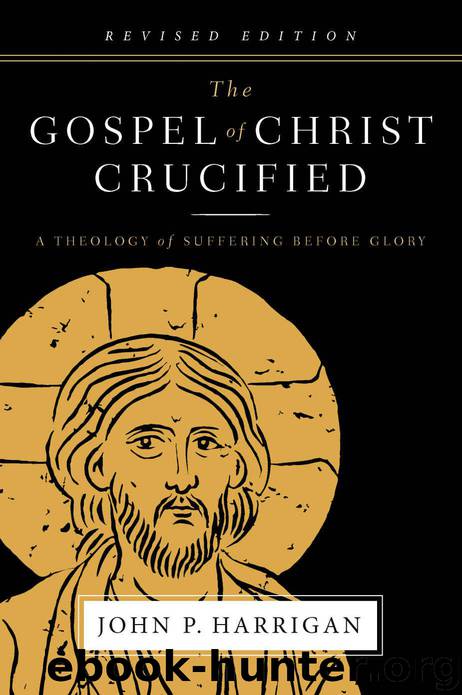The Gospel of Christ Crucified: A Theology of Suffering before Glory by John P. Harrigan

Author:John P. Harrigan [Harrigan, John P.]
Language: eng
Format: epub
Tags: [u]
Publisher: Paroikos Publishing
Published: 2019-10-28T17:00:00+00:00
CONCLUSION
The vast majority of eschatological references in the New Testament fit comfortably within a first-century Jewish apocalyptic worldview. The few verses discussed above are commonly cited as proof that Jesus and the apostles reinterpreted and transformed that worldview. But as we have seen, these verses—read in the context of their surrounding passages—are actually forceful affirmations of the Jewish eschatological hope. If realized eschatology (i.e., the “already” of inaugurationalism) is nonexistent in the New Testament, what then are we left with? Precisely—Jewish apocalypticism, which must be augmented with a cruciform theology. Such a worldview lies behind Jesus’ rhetorical question: “Was it not necessary that the Messiah [Jewish] should suffer these things [cruciform] and then enter into his glory [apocalyptic]?” (Luke 24:26, NRSV).
Why then speak so forcefully against realized eschatology? It is often claimed that believers will not engage the world and its culture apart from the motivation of realized eschatology. However, I find this logic to be both flawed and lethal. It is flawed in that motivation is driven by convictions of truth and falsehood, love and hate, reward and punishment, etc. Such convictions can apply equally to things of this age (realized eschatology) or things of the age to come (apocalyptic eschatology). I believe motivation derived from eternal realities tends to foster holy ambition, whereas motivation derived from temporal realties tends to create vain ambition. An eternal inheritance is actually a better motivator than a temporal inheritance (or at least it ought to be!).
As such, realized eschatology is also lethal, primarily for three reasons. First, it destroys believers’ joy in the blessed hope by setting their minds and hearts on an inheritance in this age, while simultaneously mitigating their urgency concerning the imminence of the day of the Lord. This approach erodes an eternal perspective and creates a fundamental worldliness within the church, as evidenced throughout the church’s Constantinian history.
Second, realized eschatology tends to disqualify believers from the eternal inheritance by changing the standard of discipleship in this age from the cross to a spiritually realized kingdom (i.e., the cross is no longer the embodiment of the will of God in this age but rather a simple historical event which only enabled the present kingdom). This approach seems to inevitably lead to believers laying down their crosses, so to speak, and rejecting a theology of suffering.
Third, realized eschatology deludes believers into supersessionist beliefs concerning the spiritualization of Israel and the jettisoning of the unique calling of the Jews in redemptive history. The church becomes the “new Israel,” and Jews are too often held in contempt. Again, realized eschatology irreparably damages the biblical timeline, particularly concerning (1) the day of the Lord, (2) the cross, and (3) Jewish election. Thus, at every turn realized eschatology contradicts the Jewish cruciform-apocalyptic testimony of the Scriptures.
For this reason, I resonate with Paul’s description of the realized eschatology of his day as “irreverent babble” (1 Tim. 6:20; 2 Tim. 2:16). It is babble because it usually goes on and on, with little or no correspondence with reality.
Download
This site does not store any files on its server. We only index and link to content provided by other sites. Please contact the content providers to delete copyright contents if any and email us, we'll remove relevant links or contents immediately.
The Hatha Yoga Pradipika (Translated) by Svatmarama(2482)
Real Sex by Lauren F. Winner(2475)
The Holy Spirit by Billy Graham(2418)
The Secret Power of Speaking God's Word by Joyce Meyer(2253)
The Gnostic Gospels by Pagels Elaine(2026)
Devil, The by Almond Philip C(1899)
23:27 by H. L. Roberts(1892)
Jesus by Paul Johnson(1887)
The Nativity by Geza Vermes(1849)
All Things New by John Eldredge(1781)
Chosen by God by R. C. Sproul(1760)
Angels of God: The Bible, the Church and the Heavenly Hosts by Mike Aquilina(1628)
The Return of the Gods by Erich von Daniken(1573)
Angels by Billy Graham(1549)
Evidence of the Afterlife by Jeffrey Long(1460)
Knowing God by J.I. Packer(1431)
The Gnostic Gospel of St. Thomas by Tau Malachi(1412)
Victorian Sensation by James A. Secord(1406)
How To Be Born Again by Billy Graham(1404)
